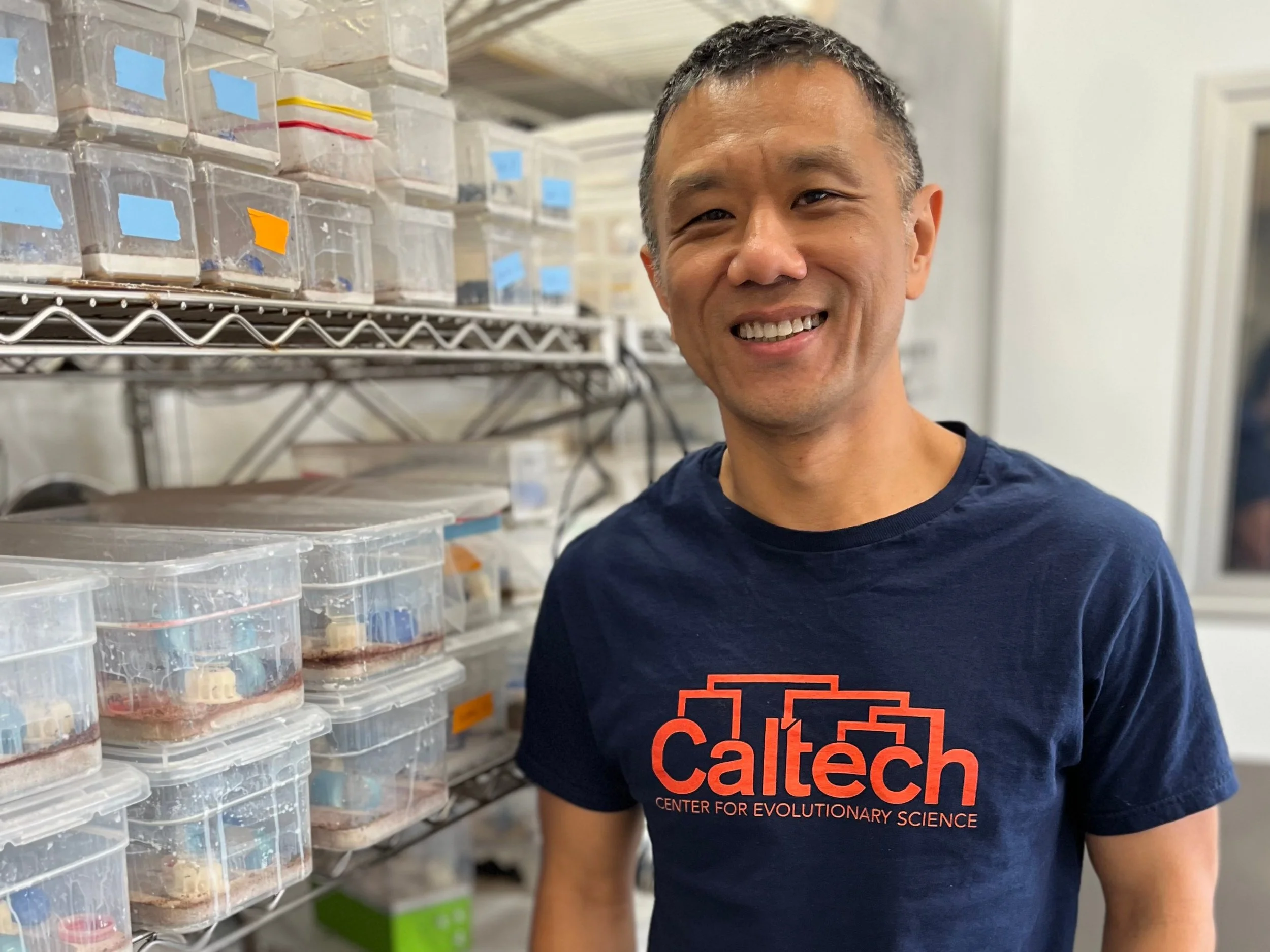He Animated Elsa’s Hair in 'Frozen.' Now He Wrangles Ants in a Caltech Lab.
John Truong tends to ants in Joe Parker’s lab. Photo: Omar Shamout
John Truong, a research support technician in the Division of Biology and Biological Engineering, kept his passion for ant keeping a secret for most of his life.
By Omar Shamout
When John Truong walked into his local donut shop seven years ago, he was not expecting to walk out on a path to Caltech.
The former animator found himself at a crossroads after a decade spent working on major Hollywood films such as Frozen, How to Train Your Dragon, and Big Hero 6. “I made every bow tie in Ratatouille,” Truong says, laughing. “That was my first job. And anytime you see Elsa move in Frozen, I did the hair and cape.”
John Truong in Joe Parker’s lab. Photo: Omar Shamout
Although he had been drawing for as long as he can remember, the 60- and 70-hour work weeks took a toll on Truong’s health. In 2015, he left animation and pursued photography, shooting events for DreamWorks and other entertainment studios. But for decades, Truong had harbored a secret passion not even his parents, siblings, nor friends knew about.
Truong had started collecting ants at the age of 11, first in his parents’ garage in Texas and later in his Monterey Park, California, apartment (a fact he kept from his landlord at the time). His colonies live in habitats he crafts by hand. Truong has several colonies in his home, each containing hundreds—and even thousands—of ants that are reared from a single newborn queen collected in the wild. Though he collects different species, his favorite ants to keep are honeypot ants (named for their bulbous orange abdomens) because they are friendly and do not sting.
“I consider ants to be pets because they are a very social insect,” he says. “Some of them are pests, sure, but there are many that don’t bite or invade your kitchen. And when a newborn queen ant starts laying eggs to start her own colony, she’ll feed her young mouth to mouth like a mother bird. She’ll groom them and care for them.”
After leaving animation, Truong began selling queen ants online as a way to fund his hobby. Most of his customers were the parents of children who wanted to start their own colony at home. It is legal to sell ants native to California within the state.
“In the past 10 years, I’ve probably spent $3,000 in gas each year driving all over California looking for queen ants,” Truong says. “I would go out into the desert and look for different species. I felt like I was throwing money away, so I sold ants on the side, and that’s how Joe found me.”
John Truong searches for honeypot ants near Palm Springs in November 2024.
An “Interesting Proposition”
Joe Parker (left) with John Truong.
Joe Parker, a Caltech professor of biology and biological engineering and recent MacArthur Fellow, had joined the Institute in 2017. His lab studies a group of rove beetles that have evolved to emit chemicals that mimic the pheromones of the velvety tree ant, enabling the beetles to live symbiotically with the ants and even prey upon them.
“I wanted to have velvety tree ant colonies in the lab,” Parker recalls. “So, in 2018, I found this website for local ant enthusiasts, and John was selling the queen ants I needed, so I emailed him.”
“Joe said, ‘I want to buy all of them,’” Truong remembers. “His email signature said ‘PhD’ and ‘Caltech,’ so I knew he must be smart, but I told him, ‘You know these ants are aggressive, right?’ He said, “Oh, I know, and they smell too.”
Truong likes to meet potential buyers in public places, so the pair arranged the fateful encounter to take place in the parking lot of Pronto Donuts in Monterey Park, not far from Truong’s apartment. Unfortunately, the first group of ants Parker bought for his lab died. The second did not survive either. So, he came back a third time.
“My plan was to culture them myself,” Parker says, “but I was too idealistic; I had zero bandwidth to raise colonies of ants as well as the beetles I was keeping. So, I said to John, ‘I have an interesting proposition for you. How would you like to be the Caltech ant keeper?’” Parker remembers.
As a freelance photographer, Truong had a flexible schedule, but he had never entertained the idea that his myrmecological hobby could lead to a career. At first, Truong had major doubts about whether he was up to the task. “When I emailed Joe back, I even said in all caps, ‘You know I am an art major, right?’”
But the entomologist and evolutionary biologist says he was not worried about Truong’s credentials. “I saw a kindred spirit in him,” Parker says. “I could instantly see that this is a person who’s very invested in these organisms and who’s really paying attention to them. It’s a magical thing when you encounter somebody else like that.”
Truong accepted the job and now balances his work as a photographer with his part-time role in Parker’s group caring for dozens of different ant colonies, each inhabiting its own tray in the lab. Truong comes in each day to feed the ants a diet of nectar, crickets, mealworms, and roaches. He checks the nests for mold (which could kill the ants) and makes sure no insects have escaped. Truong coats each tray with fluon, a chemical that prevents the ants from climbing up the sides, though the specimens sometimes manage to carve a path up and out of the tray.
“We have about two or three escapes a week, but they’re minor,” Truong says. “If you catch them early, they won’t have a chance to invade the colony next door and kill them. I've got many other species in the lab now, but the only ants that escape are the ones that Joe studies. I give him a hard time about it. I tell him, ‘Why can’t you study honeypot ants? It would be a lot easier.’”
Truong may have doubted his own prowess initially, but Parker says his lab would not be able to function without his ant keeper’s invaluable skills.
“John is probably the only person in a several-hundred-mile radius who could do what he’s doing,” Parker says. “His expertise in culturing many different species of ants is not something you can get from a degree in biology or zoology. It’s through pure love of these insects and learning the methods to keep them alive as a hobbyist that you get this kind of expertise.”
Recently, Parker presented Truong with a new challenge. For the first time, his team is attempting to integrate its rove beetle subjects into velvety tree ant colonies within the lab. However, it has been difficult to replicate the symbiotic relationship between these species that exists in the wild.
A velvety tree ant colony in Joe Parker’s lab. Photo: Omar Shamout
“So far, every time I’ve acclimated the beetles into the colony, they’ve killed the workers and the queen,” Truong says. “Our thinking is that the colony is not large enough. So, that’s what I’m working on. We’ll have to have about 40 or 50 colonies in total. I’m taking these colonies to a huge scale—massive.”
Parker says he is confident they are on the right track thanks in large part to Truong’s efforts.
“If we’re able to do this, and we really think we can, then it would open up a whole new line of experimentation to be able to study the interaction between the beetles and ants in a much more naturalistic setting than we’ve been doing, which is studying one-on-one interactions,” Parker says. “This would include learning more about the ecological impact of having these beetles inside a colony and the influence of the presence of the beetles on the collective behavior and fitness of the ants at the colony level.”
A Burrowed Secret
It took Truong decades to hone his ant-keeping skills—and he did it without telling a soul. The reason can be traced to his family’s history.
Truong was born in Saigon, Vietnam, in 1974, to an ethnically Chinese family. Many ethnic Chinese and others living in Vietnam fled the country in the late 1970s to avoid persecution from the government—an exodus whose members became known as the Vietnamese Boat People.
“We left with about 200 other people on a boat in 1978 and sailed to Bidong Island in Malaysia as refugees,” Truong says. “We built our own shacks and grew our own food. I remember eating rice and soy sauce for a year.”
In 1979, when Truong was 5, a Lutheran church in South Carolina sponsored the family’s immigration to the United States. The Truongs moved to the Dallas suburb of Carrollton when John was 11. It was there that he became fascinated with the fire ants that populate the region, inspiring the hobby that became a career.
“Ants are everywhere in Texas, and you always see queen ants flying around after a hot, humid rain,” he says. “They’re looking for a place to lay their eggs. I found the first queen I collected in my front yard.”
Truong spent months figuring out how to build a colony that would allow a queen ant to give birth to its workers. Once he managed that, he had to learn what food they would eat and what conditions would keep them alive.
“It was all trial and error—there was no internet back then,” he says. “I would take a picture frame and sandwich some dirt within the frame. Then, I’d stand it up vertically, so I could see the queen dig. It worked,” Truong says. “Now, after many years of success and failure, I can keep ants alive indefinitely.”
But Truong never told his parents about his ant-keeping hobby out of fear that he would not be taken seriously. In fact, he only told his mom and dad about his job at Caltech a year after he started.
“They didn’t even want me doing art,” Truong says. “My dad wanted me to be a lawyer, or a doctor, or a programmer. Back then, I was very angry with my dad. But as I got older, I realized it was all because he loved me, and he just wanted the best for me. He knew what it was like to be poor and face hardship.”
Truong also hid his ant keeping from friends because he feared they might ostracize him or think he was “weird.”
So how did Truong’s parents react when he finally revealed his secret life after more than 30 years? “They laughed,” he says. “I think they realized that I was always different, and they’ve accepted it.”
At Caltech, Truong says he has found a welcoming environment both in Parker’s lab and in the community as a whole. He has even brought one of his other hobbies, table tennis, to campus. Last year, he sent a note to the Caltech’s online marketplace looking for a Ping-Pong partner. He got a response from Andy Ingersoll, a professor of planetary science, emeritus, and the pair have been playing together ever since. They even started a table tennis club for students last November.
“Andy reminds me of my dad, and I love that,” Truong says. “Now, I get to take care of my ants, go play Ping-Pong, and it’s wonderful. Part of the reason I like being here is that I get to meet other like-minded people. But, while they know the science, I’m proud to be the specialist who knows how to keep the ants happy and alive.”





